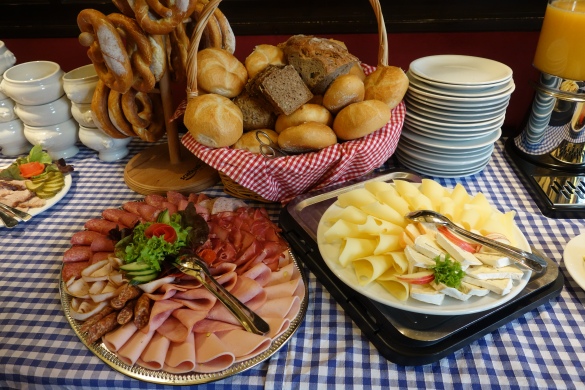What’s on your morning menu? Cereal? Some eggs? A cup of coffee? Here’s what people are waking up to around the globe, as described by a handful of the international instructors at The Language Academy of the Carolinas.
ARGENTINA

Traditional yerba mate tea is served in a gourd with a bombilla, a special straw with a filter. (photo via herbalteagoddess.com)
For Eugenia Trenkelbach, a native of San Martin de Los Andes, Patagonia in Argentina, her days usually start with toast served with cream cheese and jelly ordulce de leche (a delectable sauce made by heating sweetened milk to a rich, caramel color.)
“Most women drink mate in the morning,” says Spanish instructor Trenkelbach, referring to the highly-caffeinated beverage traditionally served in a gourd and made from dried leaves of yerba mate. “Men usually have coffee.” And while kids enjoy chocolate milk in the morning, many will drink mate with milk and sugar in the late afternoon instead of the customary 5 o’clock tea.
GERMANY

German breakfast! (photo via justtalkingabout.files.wordpress.com)
German instructor Bettina Poenisch wakes up to a big cup of coffee with lots of water and milk. “[It’s] more like drinking hot milk with a bit of coffee flavor in it,” she admits.
She says Germans typically start their day with filtered coffee (a German invention!) accompanied by Brötchen (fresh rolls), especially on Sunday mornings. “German rolls are different from American rolls,” says Poenisch, who was born and raised in Dresden, Germany. “They have a nice crust and are not sweetened. I have not yet found anything like it here in Charlotte, it’s always the first thing I go out and buy when I visit Germany.”
During the week, people often eat toast or dark bread with butter and jam or Nutella. They might also choose a savory breakfast with cold cuts or cheese. Cereal and fruit juice are also popular items.
BRAZIL

Brazil is the world’s largest coffee producer. (Photo via cafeoccidente.com)
Fresh fruit juice like orange, mango, and guava abound in Brazil but coffee is king. (Brazil is the world’s largest producer of it.) Portuguese instructor Lee Cobbs drinks her cup black but says most of her countrymen and -women drink it sweet and add hot milk to it. People often eat bread and butter, fruit, or yogurt for breakfast in her hometown of Belo Horizonte, third largest city in Brazil. But up North, she says, people eat tapioca couscous, and tapioca pancakes with sun dried meats.
“Whenever [it] is a tad bit cold we like hot chocolate, quentão (a beverage made from warm cognac, cinnamon sticks, and cloves) or gemada (our version of eggnog),” says Cobbs.
TAIWAN

Salty soybean milk is a popular Chinese breakfast item. (photo viahttp://www.theapricity.com)
Move over coffee, choices are a bit more diverse in Chinese-speaking countries, according to Taiwanese-born Yingying Lin. In the mornings, people often drink sweet or salty soybean milk, plain hot black or green tea, or soybean (tofu) jelly.
“Sugar is normally added to make sweet soybean milk,” says Lin, who teaches Chinese and whose parents hail from the southeastern coastal province of Chejiang in China. “Soy sauce, vinegar, minced pickled mustard tuber, chopped deep-fried dough sticks, dried baby shrimps, chopped green onions, [or] sesame oil are normally added to hot salty soy bean milk.”
As for favorite breakfast dishes, she says it depends on the region but small steamed buns, deep-fried dough sticks, baked crispy bread (shao-bing), fried leek dumplings, and beef pies are among the most popular items. Dim Sum, the tradition of eating small plates of many different brunch items, originated in the Southern province of Canton;today, it can be found throughout Asia and beyond.
DEMOCRATIC REPUBLIC OF CONGO

Beignets are a favorite breakfast food in the Democratic Republic of Congo. (photo via pinterest.com/cookingwitholivia)
French instructor Blaise Kazadi comes from the Democratic Republic of Congo, located in central Africa. It is the second largest country in Africa and likely one of the world’s richest in natural resources. Unfortunately, Kazadi says the region has been war-torn and exploited by many throughout its history and problems continue there today.
The country straddles the equator and has a tropical climate. It also only has two seasons that alternate throughout the year: wet and dry. “The wet season is typically very hot with high temperatures,” says Kazadi. “It makes people thirsty. So, people drink a lot of water, juice, beer, plus traditional drinks such as palm wine (le vin de palme) and lotoko, which is a home-distilled alcohol.
For breakfast, Congolese usually drink coffee alongside pain (bread) or beignets(doughnuts).
MEXICO

A typical atole and tamale vendor. (photo via i.usatoday.net)
Rodrigo Rion, vice president at the Language Academy, grew up in Mexico where there are many popular breakfast beverages and traditional foods. Common drinks include chocolate milk, fruit juice, and coffee as well as Cafe de Olla(prepared in an earthen clay pot from a mixture of ground coffee, cinnamon, and piloncillo –unrefined cane sugar) and atole, which is made from masa (corn hominy flour), piloncillo, cinnamon, vanilla, and sometimes chocolate or fruit. Depending on its preparation, atole ranges from a porridge-like consistency to a thin liquid.
Atole is often served with tamales, says Rion, and you can find vendors selling them together from metal buckets attached to large tricycles: “People will walk to work and stop [at] one of these mobile vendors on the street to get a quick breakfast.”
Cafe de Olla is popular breakfast fare in rural areas alongside savory egg dishes likehuevos rancheros, heuvos a la Mexicana, or machaca con huevos.
Special thanks to The Language Academy of the Carolinas’ instructors who contributed to this story.
Hungry for more? The Language Academy of the Carolinas offers courses in English, French, German, Italian, Mandarin, Portuguese, and Spanish at four convenient locations in Charlotte, NC. Visit our website for more details on all of our services including Business Programs, online conversation courses, translation services, and kids programs.

Recent Comments